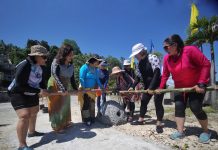By Antonio V. Figueroa
After two months of showing, the movie “Heneral Luna,” a bioflick of Gen. Antonio N. Luna, has achieved the recognition as the highest-grossing independent film ever in local cinema industry. In honor of its success, the film is entered as the country’s entry in the 2016 Oscar Awards under the foreign film category.
Not too many know that in the American-inspired National Assembly, a brother of heroes Juan the painter and Antonio the soldier represented Davao in the Legislature. This transpired at a time when Davao region was lumped under the 12th Senatorial District of Mindanao and Sulu.
His name was Joaquin Damaso Novicio Luna, the youngest of three brothers.
Father of UP’s music conservatory
Born in Manila on Dec. 11, 1874, Joaquin D. Luna joined the Philippine Revolution as a colonel and was the representative of the province of La Union in the Malolos Congress. He also served as treasurer of the Asociacion de Paz, a group that backed the surrender of arms by Filipino rebels in exchange for American amnesty.
During the American occupation, he was a key member of the Democratic Party, and was an appointed agent in the International Exposition in St. Louis, Missouri, USA. In 1902, he was elected governor of La Union and became two-term (1907-12; 1912-16) member of the Philippine Assembly, representing La Union’s first district.
In 1916, he became governor of Mountain Province and later as senator represented the 12th Senatorial District, which comprised Baguio City, Mountain Province, Nueva Vizcaya, and Mindanao and Sulu (1916-19). He authored the measure pushing for the establishment of the UP Conservatory of Music, which was created in 1908.
In his and his brothers’ honor, the town of Namakpakan, La Union, the birthplace of their mother, was renamed Luna in 1907.
Other senators
Sen. Luna was one of 10 lawmakers who represented Davao in the legislature, all of them not native to the region. The other legislators were Teofisto J. Guingona Sr., Jose Alejandrino, Manuel R. Camus, Ludovico A. Hidrosollo, Juan L. Gaerlan, Haji Butu Abdul Bagui, Lope K. Santos, Datu Mama Sinsuat and Sultan Jamalul Kiram II.
Born in Guimaras, Iloilo, on Sept. 20, 1883, Teofisto J. Guingona, Sr., father of former Vice President Teofisto Jr., was elected congressman of the second district of Negros Oriental in 1909 and re-elected in 1912. He served as governor of Agusan Province, and was acting governor of the Department of Mindanao and Sulu (1918-20). Â In 1921, he was appointed Senator for the 12th Senatorial District comprising Mindanao and Sulu.
Jose Alejandrino, born on Dec. 1, 1870, in Binondo, Manila, joined the editorial staff of La Solidaridad, served the Malolos Congress (1898) and helped draft its Constitution. In 1901, he was appointed city engineer of Manila, and in 1925 he was designated senator for Sulu and Mindanao. A member of the Partido Democrata Nacional, he was elected representative of Pampanga’s second district to the 1934 Constitutional Convention.
Born on Oct. 16, 1875, Manuel R. Camus served as an interpreter and translator for the Provost Marshal General of the US Army and became a senator (1928-31) representing Mindanao and Sulu. As a lawyer, he was a partner of Dizon and Zavalla law office; acting honorary consul for Peru; director, Metropolitan Theater Company; member, American Bar Association; and president, Community Publishers, Inc., among others.
A native of Capiz, Ludovico A. Hidrosollo was elected senator in the 1931 elections, representing the 12th Senatorial District, which included Mindanao and Sulu. He was the first Filipino public school teacher, and was director of the Department of Non-Christian Tribes and served as the 10th governor of Capiz Province (1947-51). He retired from public office in 1954.
Born in Tagudin, Ilocos Sur on July 7, 1884, Juan L. Gaerlan held numerous positions in government. He was deputy governor-at-large of Mt. Province; acting deputy governor of Apayao and Benguet; and deputy governor of Benguet. He was appointed representative for the Mt. Province (1931-34) and later as senator for the 12th Senatorial District that included the province of Davao (1934-35).
A native of Pasig, Rizal, on Sept. 25, 1879, Lope K. Santos was elected governor of Rizal Province, and appointed first Filipino governor of Nueva Vizcaya. He was elected senator in the 5th Philippine Legislature representing the 12th Senatorial District covering the provinces with majority non-Christian population. He authored Philippine Legislature Act No. 2946, making Nov. 30 of each year as Bonifacio Day.
The Muslim trio
Interestingly, three honorable Muslim lawmakers represented Davao in the Senate.
Haji Butu Abdul Bagui, born in Jolo in 1865, was a noted figure in the internal struggle of the Sultanate of Sulu during Spanish rule. In 1904, he was named assistant to the military governor of Sulu and later deputy district governor of Sulu. In 1915, he was appointed senator of the 12th Senatorial District, which included Mindanao and Sulu, becoming the first Filipino Muslim senator; in 1928, he was re-appointed to the position.
Datu Mama Sinsuat was voted in 1974 as the Outstanding Alumnus of the FEU Institute of Law. In government, he was chairman of the Commission on National Integration and senator of the 12th Senatorial District comprising the provinces of Mt. Province, Baguio, Nueva Vizcaya, Agusan, Bukidnon, Cotabato, Davao, Lanao, Sulu and Zamboanga (1934-35). He also held other distinguished positions in the private sector.
Sultan Jamalul Kiram II was proclaimed Sultan of Sulu in 1884 as the son of Jamalul A’Lam. This was contested, though, by Datu Aliud-Din, a grandson of Sultan Shakirul-Lah, but without success. The Spaniards eventually forged a deal with him despite his repeated refusal to go to Manila on a state visit. In 1915, he virtually surrendered his political powers to the US government under the 1915 Carpenter Agreement. He served as senator in the 9th Legislature (1931-34), representing Mindanao and Sulu.





